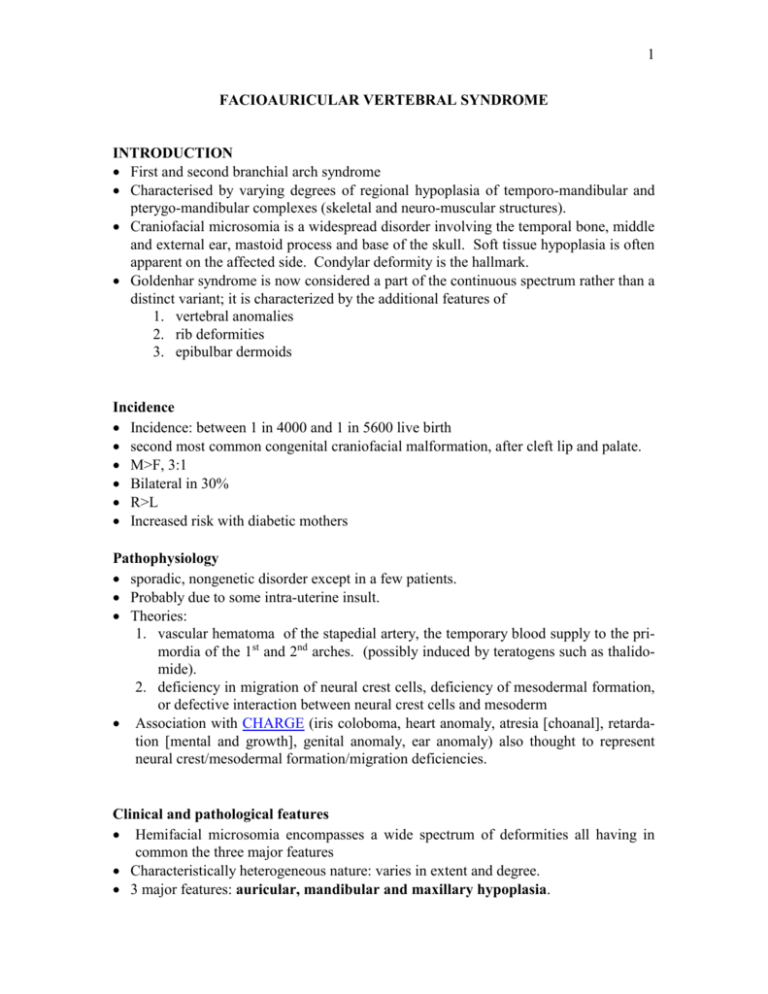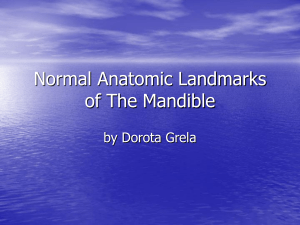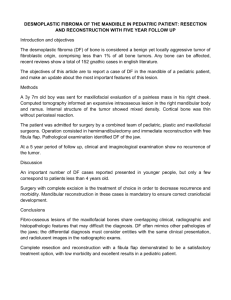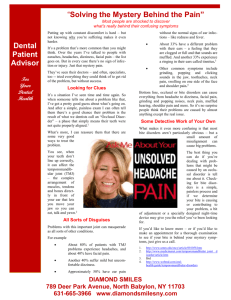CRANIO-FACIAL MICROSOMIA
advertisement

1 FACIOAURICULAR VERTEBRAL SYNDROME INTRODUCTION First and second branchial arch syndrome Characterised by varying degrees of regional hypoplasia of temporo-mandibular and pterygo-mandibular complexes (skeletal and neuro-muscular structures). Craniofacial microsomia is a widespread disorder involving the temporal bone, middle and external ear, mastoid process and base of the skull. Soft tissue hypoplasia is often apparent on the affected side. Condylar deformity is the hallmark. Goldenhar syndrome is now considered a part of the continuous spectrum rather than a distinct variant; it is characterized by the additional features of 1. vertebral anomalies 2. rib deformities 3. epibulbar dermoids Incidence Incidence: between 1 in 4000 and 1 in 5600 live birth second most common congenital craniofacial malformation, after cleft lip and palate. M>F, 3:1 Bilateral in 30% R>L Increased risk with diabetic mothers Pathophysiology sporadic, nongenetic disorder except in a few patients. Probably due to some intra-uterine insult. Theories: 1. vascular hematoma of the stapedial artery, the temporary blood supply to the primordia of the 1st and 2nd arches. (possibly induced by teratogens such as thalidomide). 2. deficiency in migration of neural crest cells, deficiency of mesodermal formation, or defective interaction between neural crest cells and mesoderm Association with CHARGE (iris coloboma, heart anomaly, atresia [choanal], retardation [mental and growth], genital anomaly, ear anomaly) also thought to represent neural crest/mesodermal formation/migration deficiencies. Clinical and pathological features Hemifacial microsomia encompasses a wide spectrum of deformities all having in common the three major features Characteristically heterogeneous nature: varies in extent and degree. 3 major features: auricular, mandibular and maxillary hypoplasia. 2 The auricular hypoplasia may range from ear tags(seen any where along the cheek from the lateral commisure to the ear) to microtia or anotia Mandible may range from mild reduction in size to marked hypoplasia with absence of glenoid fossa and complete aplasia of the ascending ramus Correlation exist between the severity of the ext ear deformity and the development of the mandible and the development of the middle ear structures Hypoplasia also involves adjacent anatomical structures: middle and external ear; mandible; zygoma; maxilla; pterygoid processes; temporal bone, including the mastoid; the facial nerve and muscles of expression; the trigeminal nerve and muscles of mastication; other cranial nerves; other muscles including those of the palate and the tongue; the parotid; the floor of the nose; the eye and the subcutaneous tissues and skin. The facial palsy is correlated with the severity of the deformity Macrostomia, a lateral facial cleft (7) and a 1st branchial cleft sinus can occur but not necessary for diagnosis. Development of the branchial arches is interlinked with the development of the chondrocranium and membranous skull. Anomalies of the branchial arches can therefore be associated with deformities of the cranial bones which can be extensive. In severe forms, all the structures derived from the 1st and 2nd branchial arches are abnormal, whereas in less severe forms, either the ear or the jaw is predominantly abnormal. Formes frustes (microforms) are more common than generally acknowledged. Multiple ocular and adnexal findings have been associated with patients with hemifacial microsomia and the epibulbar dermoid is one of the markers of goldenhars syndrome Classification OMENS-Plus system five major craniofacial manifestations of hemifacial microsomia (orbit, mandible, ear, nerve, and soft tissue) are assessed. PLUS = extracranial anomalies Each anatomic abnormality is graded from 0 to 3. Orbital grading - based on the size and position of the orbit 0. = normal 1. = abnormal size 2. = abnormal position 3. = abnormal size and position Mandibular grading - based on Kaban modification of the original classification by Pruzansky 1. = Mild hypoplasia of the ramus while the body of the mandible is minimally affected. 2. = condyle and ramus are small, the head of the condyle is flattened (a) glenoid fossa anatomically acceptable compared with opposite temporomandibular joint or 3 (b) temporomandibular joint displaced anteriorly, medially, or inferiorly with a severely hypoplastic condyle 3. = ramus is reduced to a thin lamella of bone or is completely absent. There is no evidence of a temporomandibular joint. External ear grading - based on that of Meurman 0. = normal 1. = mild hypoplasia and cupping with all structures present 2. = absence of external auditory canal with variable hypoplasia of the concha 3. = malpositioned lobule with absent auricle, lobule remnant inferiorly and anteriorly displaced). Facial Nerve involvement is categorized according to the division of the nerve involved 0. = normal 1. = upper facial nerve involved 2. = lower facial nerve involved 3. = all branches involved). Soft-tissue grading is based solely on subcutaneous and apparent muscular deficiency 0. = no obvious deficiency 1. = minimal deficiency 2. = moderate deficiency 3. = severe deficiency). In those patients with bilateral deformities, the two sides are classified separately David David uses the SAT system - Skeletal, Auricular and Tissue (soft) deficiencies 4 Diagnosis there has been no agreed minimum clinical criteria for the diagnosis of hemifacial microsomia. Cousley and Calvert (BJPS1995) suggested useful guidelines of minimal diagnostic criteria for the diagnosis of hemifacial microsomia based on the premise that either mandibular or ear defects are mandatory features, and they accordingly proposed two categories. 1. First, a diagnosis of hemifacial microsomia may be confidently made if both mandibular and ear defects are present. 2. If only one or the other is present, a diagnosis of hemifacial microsomia may be assumed if either two or more indirectly associated anomalies or a positive family history is present. 1. Jaw Deformity The most conspicuous deformity of craniofacial microsomia is hypoplasia of the mandible on the affected side. Typically the ramus is short or virtually absent on the affected side. The body of the mandible therefore curves upwards posteriorly and is longer on the affected side. The gonial angle is increased. The chin is deviated to the affected side. Usually the opposite side is also abnormal too. The condyle is always abnormal (hypoplastic), even in the most minor cases (a pathognomonic feature). With greater degrees of severity, both the condyle and the ramus may be absent. Clinically, the hypoplasia may be subtle with only a mild occlusal slant (up on the affected side) or the mid-incisor point of the lower jaw being slightly off to the one side. With growth, facial asymmetry increases, ie, the deformity is progressive. The floor of the nose, maxillary sinus and the base of the skull may follow the occlusal cant. Teeth often crowded. Cross bite occurs because with growth, the condyle lies medially. 2. Orbit Orbital abnormalities are a manifestation of hypoplasia of the entire cranio-orbitozygomatic complex, with the zygomatic complex being the central component involved. This results in secondary growth restriction on the adjacent orbit, glenoid fossa, and squamous temporal bone. 3. Other Skeletal Deformities 5 Craniofacial bones, other than the mandible and maxilla can be involved: tympanic and mastoid parts of the temporal bone; styloid process frequently shorter and smaller; frontal bone flattening. The petrous part of the temporal bone (contains the middle ear) is often spared. Vertebral anomalies (10%): hemi-vertebrae causing secondary scoliosis, kyphosis, fused vertebrae, spina bifida. Rib anomalies. 4. Muscles of Mastication Masseter, temporalis and medial and lateral pterygoids may be deficient. Soft-tissue deficiency and hypoplasia of the muscles of mastication are intimately associated with the degree of mandibular deformity According to Moss’s theory of a functional matrix (1968), bone grows in response to its functional requirements, ie the soft tissue affects bone growth by the forces it places on the bone. Absent pterygoids contribute to mandibular deviation to the affected side on mouth opening. 5. Auricular Deformity Ear abnormalities are a major manifestation of the syndrome. presence of a severely affected ear increases the likelihood of a more severely affected mandible being present. Hearing function does not correlate well with grade of external ear defect, but does correlate with severity of mandibular defect. Type of hearing loss not always conductive –sensorineural loss in 10% Need for audiometry in all patients Tomography (and CT) need to be done to determine middle ear morphology. The opposite ear needs to be evaluated too. Ear reconstruction is as for other causes of microtia. 6. Cerebral Anomalies Wide variety: ipsilateral cerebral hypoplasia, hypoplasia of the corpus callosum, hydrocephalus (both communicating and obstructive), intracranial lipoma and unilateral hypoplasia of brain stem and cerebellum. Also: mental retardation (5-15%), epilepsy. 7. Cranial Nerve Anomalies (20-45%) Multiple cranial nerves can be affected. Arhinencephaly to less extensive forms which may involve any of the cranial nerves. The commonest cranial nerve involved is the facial nerve 6 degree of external ear deformity, rather than other bony or soft-tissue defects, is a predictor of seventh nerve involvement. Remains unclear whether facial nerve dysfunction is caused by 1. an aberrant pathway of the nerve in the temporal bone 2. hypoplasia of the intracranial portion of the facial nerve 3. a manifestation of facial muscle agenesis 8. Macrostomia/Facial cleft Atypical cleft no 7 Failure of mesodermal migration or merging to obliterate the gooves between the maxillary and mandibular prominences during week 4-5 Varies from minimal lateral displacement of commissure to complete cleft of face Cheek deformity always accompanies a muscle defect 9. Soft Tissue Anomalies Often generalised soft tissue hypoplasia of skin, subcutaneous tissue and facial muscles. The musculature of the soft palate and of the tongue may be affected. palatal deviation to the normal side 10-15% have cleft lip/palate (mostly ipsilateral) epibulbar dermoids benign congenital tumors that contain choristomatous tissue (tissue not found normally at that site) - epidermal appendages, adipose and lacrimal gland tissue, smooth and striated muscle, cartilage, brain, teeth, and bone 2 theories 1. early developmental error resulting in metaplastic transformation of the mesoblast between the rim of the optic nerve and the surface ectoderm. 2. Another proposed mechanism is sequestration of the pluripotential cells during embryonic development of the surrounding ocular structures. Examination 1. Begin with forehead and the orbit and these are compared for symmetry with the opposite side 2. globe evaluated for epibulbar dermoids and extraocular muscles noted 7 3. 4. 5. 6. 7. 8. extent of auricular deformity is noted, external auditory meatus facial nerve evaluated chin deviation noted presence or absence of TMJ palpated intraoral examination for cleft and uvula deviation get child to bite on determine occlusal tilt and type a. most pts have class I relationship in spite of marked unilateral hypoplasia of the maxilla and mandible on the affected side 1. assess hearing – average hearing loss of 50 Db 2. assess for VPI as 1/3rd have VPI and palatal movement problems INVESTIGATIONS 1. X rays: facial views, cephalograms, CT head/face, MRI 2. Audiology DIFFERENTIAL DIAGNOSIS Bilateral form must be differentiated from Treacher Collins (Irregular AD inheritance with variable penetrance). Craniofacial microsomia has defects of the mandibular ramus and facial paralysis. Postnatal trauma or infection of the mandibular condylar cartilage can result in impaired growth not only of the mandible, but also of the whole craniofacial osseous complex. Soft tissues are spared. No temporal bone involvement. Severe orbito-facial clefts: Patients lack the condylar deformity. Prognosis Mulliken (PRS 2000) found that angle piriform rim, maxillary occlusal plane, and intergonial angle increased with serial measurements in 67 patients with untreated hemifacial microsomia demonstrated that hemifacial microsomia is progressive and underscores the importance of early surgical correction of mandibular asymmetry in this disorder. TREATMENT Multidisciplinary team approach best. Geneticist Paediatrician Social worker ENT Dental 8 Timing Most believe that surgery should be performed when the child is 5-6 years, rather than delaying until facial growth is complete. mandible is usually corrected first in the hope that this will unlock the growth potential of the functional matrix. Two critical variables are the age of the patient and the extent of the defect. The more extensive the defect, the greater will be the surgery required and the sooner it should be commenced. Early surgery during infancy is dictated by airway compromise (ie laryngomalacia) Surgical goals 1) normalizing the occlusal tilt- symmetry of the occlusal plane is necessary to prevent problems with the opposite TMJ 2) reconstruct the TMJ if absent 3) auricular reconstruction Surgical sequence Infancy 1. Airways a. Positioning, trachestomy 2. Feeding difficulties a. gastrostomy Age <1year a. Cleft palate b. Macrostomia correction Age 5-10 a. early mandibular surgery at age 4 to 5 years leads to normalisation of maxilla deficiencies (opens up the posterior molars and allows maxilla to grow downwards), higher graft success rate, the psychosocial advantage of attaining improved facial symmetry at a younger age, and the additional benefit that erupting teeth will assume a more normal position, making future orthodontic treatment less difficult. i. For moderate mandibular deformities (Pruzansky I – IIIb), distraction osteogenesis is method of choice ii. If mild mandibular deformities, best to wait till skeletally mature b. Auricular reconstruction Age 10-19 a. Definitive orthognathic surgery i. Sagittal split ii. LeForte 1 iii. Genioplasty 9 b. Soft tissue augmentation Evolution of surgical solutions Now most prefer single staged correction of hemifacial microsomia Obwegesar described simultaneous Leforte 1 osteotomies, sagittal split osteotomy of the mandible and reconstruction of the hypoplastic zygoma and TMJ with rib grafts Available techniques Osteodistraction Number of factors determine timing of initial distraction Early treatment favoured in theory that distraction of the mandible at an earlier age allows greater compensation of the maxilla with subsequent growth of the child ( studies yet to be pub) and better psycho benefit Problems with early surgery is that the pin placement is more difficult before mixed dentition as the permanent tooth bus occupy lot of the mandible Preop cephalometrics to determine vector of distraction Intraoral incision and corticotomy performed – distractors may be internal or external Elongation begins at 5th -7th day and advancement at 1mm /day and advancement until the chin position is over corrected and devise left in- situ for additional 6-8 weeks The problem with distraction is it requires supplemental orthodontics, doesn’t address the TMJ and zygoma, scarring and results in a cross bite elongation of muscles, ligaments, vessels, nerves, subcutaneous fat, and skin that could not be achieved by other more radical procedures is one of the main advantages of this method Indicated in Pruzansky types 1, 2a, and 2b (Monasterio) – NOT type 3. Many children, however, will require a second distraction later in life to keep up with mandibular growth. 10 Monasterio PRS 1997 – combined mandibular, maxillary distraction- incomplete Le Fort I osteotomy (pterygomaxillary junction was left intact on the unaffected side and used as the pivot point for the rotation.) and the mandibular corticotomy. Two intraosseous pins are introduced in the mandible parallel to each other. (Right) On the fifth postoperative day, intermaxillary fixation is done with elastic bands, and mandibular distraction is initiated. The diagram shows the simultaneous elongation and rotation of the middle and lower face. Skeletal surgery Traditional craniofacial reconstruction of congenital facial malformations has generally focused on the skeleton to restore facial symmetry. These techniques include osteotomies with orbital, frontal, maxillary, and mandibular repositioning as required. Onlay or interpositional bone grafts also are utilized. More recently, bone expansion has been applied for reconstruction of the mandible and zygoma. Costochondral grafts for reconstruction of the temporomandibular joint complete the armamentarium. Panorex and cepaholometrics are used and CT with 3d recons are used and preop planning models and dental models are made Patients with mild involvement and intact TMJ treated with two jaw procedure ie bilateral mandibular osteotomies and standard Leforte I osteotomy Replase may occur due to soft tissue constraints In moderate to severe cases TMJ reconstruction with malar and zygomatic augmentations needed Surgery performed at age 6-7 Surgical planning with cepalometrics AP cephologram used to determine the occlusal plane and vertical midline then drawn from the upper facial skeleton from a perpendicular drawn through the orbital roofs The degree of occlusal tilt is determined by a line paralleling the nasal floor and comparing this with the line drawn along the supraorbital rims. The vertical difference 11 between these two lines is used to determine the amount of lengthening needed on the affected side and may need some reduction in the maxillae on the opposite side The amount of forward rotation of the maxillae is determined on physical exam based on the measurement of the distance between the dental and facial planes High leforte 1 osteotomies performed and the maxillae is rotated forward on the affected side bringing the dental midline into the facial midline. Lengthening of the maxillae is overcorrected by 2-3 mm and conformed by measuring mid facial height Sagital spilt osteotomies are then performed on the affected side and using the occlusal splint the pt is placed into imf. A Rib grafts with a cartilage cap is harvested from the contralateral chest taking advantage of the appropriate curvature. The distal 1cm of the cartilage cap is cut free for creation of the glenoid fossa. A secondary rib graft is secured to the anterior maxillary wall medially and the temporal bone posteriorly to create the arch for appropriate projection. The inner surface of the arch is burred out to accept the cartilaginous cap which is then secured with 28 G wire and heavy sutures The cartilage graft is then placed into a tunnel created from the body of the mandible to the preauricular incision. The cartilaginous end of the rib graft is seated firmly into the new glenoid fossa and the distal rib is secured to the distal border of the mandible with plate fixation IMF removed and occlusion checked. Turnover flap used for cover of TMJ recon The rib grafts may under or over grow and need revision Variations 1. Onlay grafts have used autologous rib, allografts of cartilage or bone, preserved cartilage allografts and inorganic implants. Problems with bone graft are: i. failure to correct occlusal problems ii. growth iii. resorption 2. Pedicled vascularised bone a. Vascularised temporal bone flap (based on deep temporal artery or STA) have been used for malar defects 3. Vascularised bone transfer (fibula, ilium, radius) could also be used. i. Fibula has been raised with growth center proximally. Soft tissue contour correction Bony correction, especially with onlay grafts of the malar area must precede soft tissue reconstruction Multiple flaps have been tried: tube flaps, de-epithelialised flaps and dermis fat grafts. De-epithelialised microvascular free flaps of dermis and fat using delto-pectoral, groin or omentum have been used. Dermis side down permits better adherence (less ptosis) McC recommends only correcting soft tissue defects at 15 years of age. Historically, the free deltopectoral dermal-fat flap was first used to treat hemifacial atrophy patients. 12 However, because the donor deformity can be very severe in younger patients, the vascularized groin dermal-fat flap has become the first choice for minimal donor-site scarring in children and female patients. The major disadvantage of this flap is that the primary defatting can be difficult because the pedicle vessel runs in a deeper layer from the flap's proximal to distal portion. Therefore, staged defatting is usually required to correct bulky fat. In 1992, Stern et al. and Upton et al. reported that a scapular and parascapular flap resulted in a more satisfactory donor scar, although it could not be selectively trimmed. care must be taken to excise all ear cartilage remnants or pits in the hemifacial microsomia patients to prevent buried sinuses or cysts Longaker (PRS Nov 1996) prefers versatility of the circumflex scapula axis 1. separate skin islands can be used 2. additional bulk can be obtained with the use of serratus anterior or teres major 3. Where the tissue requirements call for thin tissue, extensions of dorsal thoracic fascia between the subcutaneous and muscle planes are incorporated into the flap. 4. The lateral border of the scapula with bony lengths up to 15 cm in older patients can be incorporated into the flap by maintaining the bone branches of the vascular pedicle as required for concomitant mandibular reconstruction. This bone is satisfactory for straight, non-tooth-bearing bony segments as required for mandibular ramus reconstruction Auricular reconstruction Once skeleton reconstructed and the position of the ear determined auricular recon performed 13 Macrostomia Treatment of macrostomia is done during first year (after cleft lip repair if present) goals of surgery for macrostomia are (1) symmetric placement of the oral commissure, (2) reconstruction of the orbicularis to restore labial function, (3) reconstruction of a commissure with a normal appearing contour, (4) closure of the buccal defect with a minimally visible scar, and (5) prevention of future scar contracture with lateral migration of the commissure Mark new commissure: 1. Measure nasal spine to commissure (beware distortion by endotracheal intubation) 2. observation of the point at which the texture of the vermilion changes from normal mucosa to cleft mucosa 3. finding the end of the white line Muscle repair stump of the superior orbicularis oris is placed over the inferior stump to create a normal contour, and sutured under adequate tension based on where the commissure is going to be placed. This repair is crucial in obtaining normal sphincter-like function of the muscle, necessary in both articulation and mastication The buccal musculature (buccinator and risorius) should also be approximated to fill the defect in the cheek Skin repair 1. Z plasty Central line of the Z was placed along the nasolabial fold or the relaxed skin tension line (RSTL) Problem was the scar became more visible, especially on smiling Commissure position more easy to adjust 2. Straight line Better scar May relapse- tends to be retracted inferolaterally due to contracture there is difficulty in adjusting the position of the commissure of the mouth A compromise is multiple Zs or placing a small Z in the nasolabial fold. Orbital dystopia For those pts with orbital dystopia, treatment commenced at 4-5 14 Treat with orbital floor grafts to four wall orbital osteotomies May have associated frontal flattening – frontal advancement Epibulbar dermoids superficial sclerokeratectomy, cutting flush with the surface of the globe, is the procedure of choice for removal of the dermoid. Attempts at complete removal are unnecessary. Parotid gland hypoplasia places the branches of the VII nerve in a more superficial and vulnerable position. Facial nerve paralysis Most often, marginal mandibular paralysis is seen, although paralysis of the complete facial musculature may be present. Surgical options for the paralyzed marginal mandibular branch in the normal face have been reported using a variety of muscle transpositions to the lower lip, including the orbicularis oris, platysma, mylohyoid and anterior belly of digastric muscles, all with pleasing results. Free-muscle transfer has been used to recreate the lower lip depressor function in isolated deficits and as a double muscle transfer in cases of complete unilateral palsy. Reinnervation using hypoglossal nerve transfer to the lower lip musculature has had less satisfactory results. studies on marginal mandibular branch reanimation, assessing all the above techniques, have concluded that local muscle transfers offer the best results in the otherwise normal face. Beware that not infrequently platysma muscle or anterior belly of digastric muscle may not be present BILATERAL CRANIOFACIAL MICROSOMIA Variable: mild to severe. 15 Most patients show bilateral microtia and mandibular micrognathia with a class II dental occlusal relationship and an anterior open bite. Macrostomia and transverse facial clefting can occur. Almost always asymmetrical Surgical Reconstruction Goals: 1. Restoration of mandibular size, form and position. 2. Correction of malocclusion. 3. Correction of bony and soft tissue deficiency, especially in the mental region. Methods of achieving goals 1. Osteotomies: vertical (posteriorly), sagittal (ramus), horizontal (genioplasty). 2. Bone grafts: interpositional, onlay. Vertical osteotomies (+ bone graft) are suitable when the ramus is small as it es the AP and vertical dimensions of the mandible. Sagittal split osteotomy is used when the ramus is larger, but the occlusion requires correction. Horizontal osteotomies are done anteriorly as a genioplasty when the occlusal relationship is okay. Orthodontics, IMF, etc are also important.






